- Home
- Encyclopedia
- Finis Mitchell, Mountaineer
Finis Mitchell, Mountaineer
In the summer of 1952, Finis Mitchell was hiking alone in the northern Wind River Mountains in western Wyoming. Descending to a nameless lake in the Fremont River gorge, a 74-pound pack on his back, Mitchell came to a 40-foot cliff. Tying his rope to a spruce near the brink, he let himself down. As he neared the bottom, a limb broke off the tree. He landed on his pack among the rock debris at the base of the cliff.
“I named this lake ‘Suicide Lake,’” he wrote, two decades later. “If you want to commit suicide, it’s pretty easy to do it here. … [Some of] the ledges run sheer into the water.”
Mitchell, nearly 51 at the time of his fall, had been exploring the Wind River Mountains all his life, learning more about the ups, downs, ins and outs of the range’s 3,500 square miles than even the professionals who mapped it and the U.S. Forest Service officials who maintained its trails. Eventually he acquired the nickname “Lord of the Winds” for his curiosity, enthusiasm and expertise.
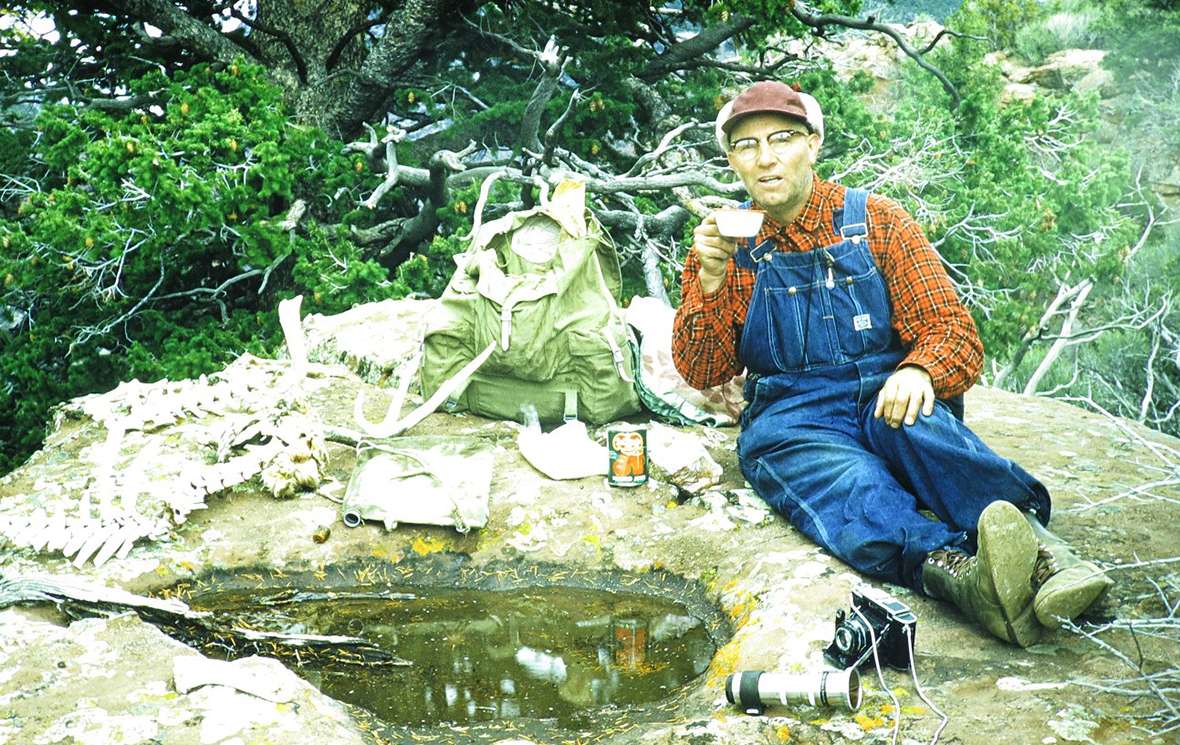
Early life
Finis Mitchell, whose name is pronounced Fine-us, was born in Missouri on Nov. 14, 1901. When he was about 5 years old, his father sold the family farm to buy 160 acres in Wyoming, sight unseen. Henry and Fay Mitchell and their three children traveled west in a boxcar with their livestock and all their other possessions. Their new land turned out to be at the base of the Wind River Mountains on the western side, near present Boulder, Wyo., but it was too dry, barren and cold for farming. To survive, “[w]e hauled rough lumber and freight to our community store,” Mitchell told Backpacker magazine 60 years later. “[We] just about lived on fish, antelope and potatoes.”
From the day they arrived, the beauty and grandeur of the Wind Rivers fascinated Finis. At age 8, on an October elk hunt, he climbed to a high point and gazed at the vast spectacle of mountains and snow-capped peaks, as far as he could see.
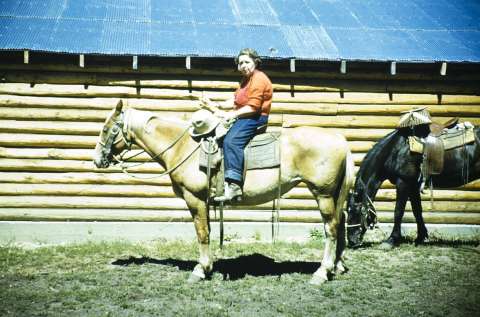
In 1915, Henry and Fay Mitchell moved to Rock Springs, Wyo., where Henry worked in a coal mine. When he developed lung problems, Finis left school after the eighth grade and worked at a sawmill to help support the family. Though he never returned to school, he continued his education with correspondence courses.
The Union Pacific Railroad Company hired Mitchell in 1923 as a carman, which meant he was responsible for maintenance and repairs.
Two years later, on June 4, 1925, Finis married Emma Nelson. She taught at an isolated one-room schoolhouse and as a teenager had cared for her sisters and brother after her mother died. Finis and Emma lived in Rock Springs; Finis continued to work for the Union Pacific until he was laid off in 1930 near the start of the Great Depression. During these years, they had two children, Anna and William.
Mitchell’s Fishing Camp
“In June 1930,” Mitchell wrote, “my wife and I bought a tent, borrowed horses and saddles [from local ranchers] and started our Mitchell’s Fishing Camp in the Big Sandy Openings … on Mud Lake” in the southern Wind Rivers. They obtained a Forest Service lease, “followed the sheep wagon road to its end and set up our tent.”
Describing their camp’s operation, Mitchell wrote, “We would take the people fishing on the horses and be sure they caught their fish. Our guide service was for free. … We charged a dollar and a half a day for horses. We kept the dollar and gave fifty cents to the people we borrowed the horses from. … We also served meals in the tent for fifty cents a meal.” During the winter, Finis worked for local ranchers. Finis and Emma ran the camp for seven years. After Finis’ mother, Fay, died, his father helped Finis and Emma.
Stocking lakes and streams
To increase the number of fish for the success of their camp, and also as part of a larger citizen volunteer effort coordinated by the Wyoming Game and Fish Commission to introduce more trout species into the waters of the Wind Rivers, Finis and Henry hauled in small trout—fingerlings—to lakes near their camp. In 1931, Finis and his father took six horses, each loaded with two milk cans of water containing about 1,000 fingerlings, up rough trails to empty the cans into various lakes. The fingerlings were supplied by the fish hatchery at Daniel, Wyo.
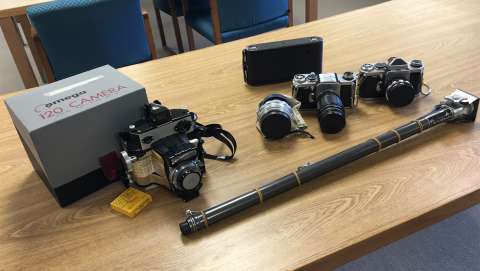
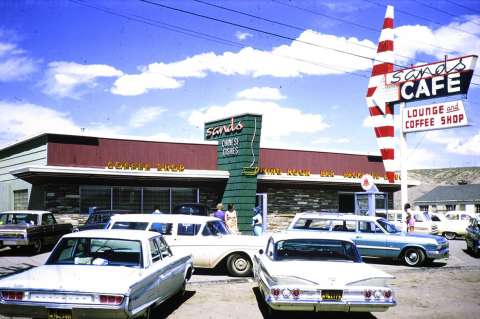
In this tricky process, the water in the cans had to be oxygenated by sloshing around. Burlap covered the cans, letting air in but keeping the trout from spilling out. During the 1930s, Finis, by his own estimate, stocked about 2.5 million fingerlings in 314 lakes.
Return to Rock Springs
When the Union Pacific rehired Mitchell in 1940, the family moved back to Rock Springs, where they settled. Mitchell worked again as a carman and later as a car foreman. At every opportunity during the warm weather, he photographed, hiked and climbed in the Wind Rivers, gaining comprehensive knowledge of trails, peaks and watersheds. By the early 1940s, he was presenting slides and talking to local groups, promoting the Wind Rivers and emphasizing the need for conservation.
From 1955 through 1958, Mitchell served in the Wyoming House of Representatives. In 1966, he retired from the railroad. A few years later, he began printing and selling postcards featuring his scenic photos. He also sold photograph albums, including a guide to hiking trails in the Wind Rivers commissioned by the U.S. Forest Service.
In 1975, Mitchell published Wind River Trails: A Hiking and Fishing Guide to the Many Trails and Lakes of the Wind River Range in Wyoming. In addition to hand-drawn maps showing innumerable lakes, streams and peaks, plus detailed directions for accessing and negotiating more than 50 trails, this 142-page book includes black-and-white photographs of lakes, peaks and glaciers plus a few of Mitchell’s Fishing Camp. The book is sturdily bound yet small enough to fit in a hiker’s pocket.
The author’s homilies, suggestions and general observations about the area enliven the narrative. On gear: “Never wear shoes with leather soles in mountains. They get as slick as greased glass.” On summertime, high-altitude snowstorms: “[J]ust hole up somewhere [in your sleeping bag] and don’t panic. … There’s no use getting excited and trying to run out of the mountains because it’s just a summer storm and to be expected.” Directions for the Mill Creek Route to Faler Lake and Bear Lake once the trail disappears: “You can’t go anywhere but the right place because you’re surrounded by thousand foot ledges.”
National recognition
In 1973, the United States Geological Survey, suspending its policy against naming landforms for living persons, named a peak in the southern Wind Rivers near Cirque of the Towers after Mitchell’s family. They installed a bronze plaque commemorating his 11 ascents. After that, he climbed Mitchell Peak seven more times.
In July 1977, the University of Wyoming awarded Mitchell an honorary Doctor of Laws degree for outstanding service in environmental awareness and conservation. Around this time, national press coverage of Mitchell’s activities began. Backpacker magazine interviewed him for its October 1977 issue. An undated Los Angeles Times clipping at the Wyoming State Archives gives Mitchell’s age as 77, which would date the article about 1978. The article quotes the noted Wyoming geologist David Love on Mitchell’s knowledge of the Wind Rivers: “He is the authority on Wind River geography.”
In 1979, the Wall Street Journal also featured Mitchell, reporting that the USGS was consulting him about their maps of the Wind Rivers. Mitchell corrected the locations of Klondike Peak and Alpine Lakes from his encyclopedic knowledge of the area.
On March 20, 1980, Mitchell presented a lecture and slide show to the Sierra Club’s Chicago, Ill., group at the Chicago Academy of Science. The poster advertising his talk noted, “He will also discuss the scandalous way America’s public lands are managed.” While in Chicago, he was interviewed by the Chicago Tribune and Chicago Sun-Times. Later that year, the U.S. Forest Service bestowed a conservation award on Mitchell and four other individuals.
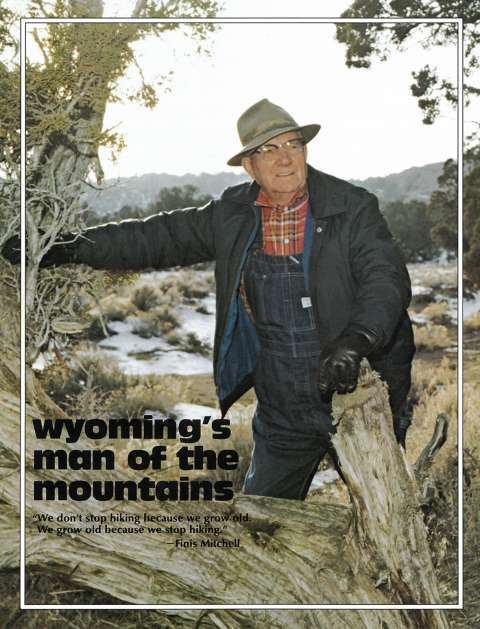
By 1981, Mitchell was guiding groups of hikers in the Wind Rivers, outpacing many younger people and choosing the trails. During the 1980s, more publications, including Union Pacific Info, Rocky Mountain Magazine and Audubon featured stories about Mitchell. He went on more speaking tours and won more awards, including honors from the U.S. Environmental Protection Agency, the Izaak Walton League and honoraria from the state senates of Wyoming and California. In the 1990s, Western Wyoming Community College in Rock Springs dedicated its dining room to Finis and Emma. In 1992, Sports Afield published an article about him.
Later years
Though slowed by aging, a stroke in 1982 and a serious knee injury from a fall into a glacier crevasse in 1985, Mitchell continued hiking in summer and promoting the Wind Rivers in winter. Katharine Collins, author of a feature about Mitchell for the Casper Star-Tribune in the 1990s, recalls that “people from all over the country would come to see him” at the Mitchell home in Rock Springs. He had a “little routine” in which he showed his photographs, honors and awards and told stories.
Finis’ and Emma’s granddaughter, Sandra Snow, remembers that “he was [a] pretty scary [driver] because he would be gawking at the scenery instead of the road. … [W]hen he was taking pictures he would wait for hours for the clouds to get in the right position. If he was taking shots of people he was just as bad about making you wait.”
And the woman behind the man? Emma Mitchell’s fruitcake, by Finis’ description, “has everything the body needs,” and he always took it on his backpack trips. Snow says that her grandmother, only about 5 feet tall, “was a tiny little dynamo. She was the glue that kept all the extended family on both sides together. She never complained about ... anything she had to do. She catered to Grandpa's every need although she used to get irritated when he couldn't find things.”
Mitchell’s knee injury caused major circulatory problems, and eventually his leg was amputated. He died on Nov. 13, 1995, one day before his 94th birthday, in a Green River, Wyo., nursing home. Emma survived him by about two years, leaving two children, three grandchildren and four great-grandchildren.
Legendary status
Pinedale resident Ric Samulski plays the part of Finis Mitchell at the annual Wind River Mountain Festival, held in Pinedale, Wyo., on the west side of the Wind Rivers, every July. Samulski did not know him, but it is a measure of Mitchell’s stature that “somebody has to impersonate Finis” at this festival, “so I do.” Samulski adds, “The legend has become larger than the man.”
Before Mitchell explored the Wind River Mountains—though others had preceded him—the area was much less well known to early tourists than the nearby Tetons and Yellowstone National Park. Thanks to his enthusiasm and tireless promotion, hundreds of thousands of hikers and climbers now enjoy that vast range every season—often with his little book in a backpack pocket.
Resources
Primary Sources
- Blundell, William E. “A Mountain Man, Aged 77, Still Has Some Peaks to Climb.” Wall Street Journal, Sept. 20, 1979. Box 1, Folder 1, Finis Mitchell Papers, Collection 03190, American Heritage Center, University of Wyoming, Laramie, Wyo. (Hereafter AHC). Also Finis Mitchell OH-2010, Wyoming State Archives, Cheyenne, Wyo. (Hereafter WSA).
- Collins, Katharine. Telephone interview with author, May 14, 2018.
- Fogarty, Jim. “Wyoming’s Man of the Mountains.” Union Pacific Info, June 1981, 21-22. Box 8, Folder 17, Finis Mitchell Papers, Collection 03190, AHC.
- Gustkey, Earl. “The mountain man: He names the peaks he climbs, talks to sheep and elk and travels alone.” Los Angeles Times, n.d. Finis Mitchell Collection OH-2010, WSA.
- Junge, Mark. Finis Mitchell Oral History, WSA. Accessed May 18, 2018, at http://spcrphotocollection.wyo.gov/luna/servlet/view/all/what/Wyoming+Album-Mark+Junge+Collection?showAll=where&sort=oh_%2Cproject%2Cinterviewed%2Cnarrator&os=150.
- Kerasote, Ted. “Finis Mitchell—Caretaker of the Winds.” Sports Afield, Dec. 1992, 42, 44. Box 8, Folder 17, Finis Mitchell Papers, Collection 03190, AHC.
- Mitchell, Finis. Wind River Trails: A Hiking and Fishing Guide to the Many Trails and Lakes of the Wind River Range in Wyoming. Salt Lake City, Utah: Wasatch Publishers, Inc., 1975, 6-15, 32, 50.
- Robinson, Doug. “The Hidden Mountains.” Rocky Mountain Magazine, July-Aug. 1981, 53-55. Box 8, Folder 17, Finis Mitchell Papers, Collection 03190, AHC.
- Samulski, Ric. Actor, Pinedale, Wyo. Telephone interviews with author. May 18 and 21, 2018.
- Snow, Sandra. Granddaughter of Finis and Emma Mitchell. Emails to author. May 8-11, 15-16 and Aug. 14, 2018.
- Udall, James. “Finis Mitchell, Lord of the Winds.” Audubon, July 1986, 72-87. Box 8, Folder 16, Finis Mitchell Papers, Collection 03190, AHC. Also available online. Accessed May 2, 2018, at https://randyudallenergy.com/wp-content/uploads/2014/11/FINIS-MITCHELL.pdf.
- “The Wind River Mountaineer/Photographer: Finis Mitchell.” Backpacker, Oct. 1977, 30-35, 70-72. Box 8, Folder 17, Finis Mitchell Papers, Collection 03190, AHC.
Secondary Sources
- “Big Sandy Trailhead.” United States Forest Service. Accessed Aug. 17, 2018, at https://www.fs.usda.gov/recarea/btnf/recreation/hiking/recarea/?recid=71741&actid=51.
- Nichols, Jeffrey. “These Waters Were All Virgin: Finis Mitchell and Wind River Wilderness.”Annals of Wyoming 76, no. 2 (Spring 2004): 26-35. Accessed April 26, 2018, at www.archive.org/details/annalsofwyom76142004wyom.
- _____________. “These Waters Were All Virgin: Finis Mitchell and Wind River Wilderness.” Unpublished manuscript, 2003. Personal collection of Sandra Snow. This is a longer version of the Annals article cited above.
- “Wind River Mountain Range.” VisitPinedale.org. Accessed May 22, 2018, at http://www.visitpinedale.org/explore/mountain-ranges/wind-river-mountain-range.
- Woods, Rebecca. Walking the Winds: A Hiking and Fishing Guide to Wyoming’s Wind River Range.2d ed. Jackson, Wyo.: White Willow Publishing, 1998.
Illustrations
- The photos of Finis and Emma Mitchell, the Sands Café and the image of the cover of the Union Pacific Railroad magazine are all from the collections of the American Heritage Center at the University of Wyoming. Used with permission and thanks.
